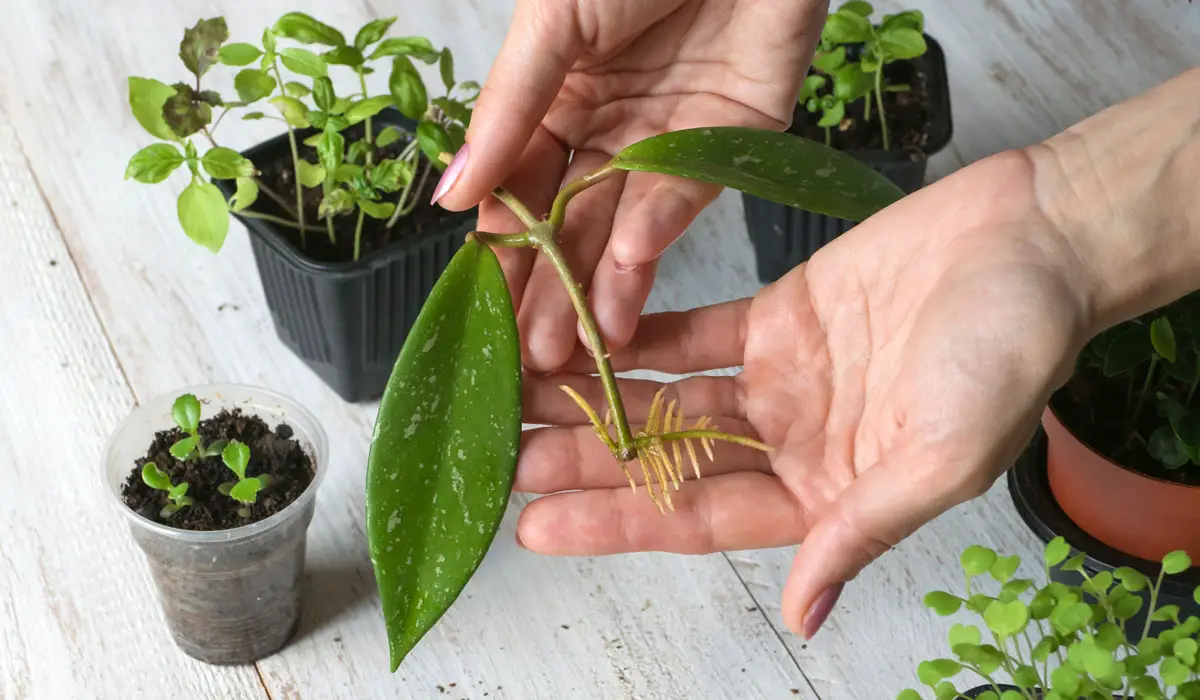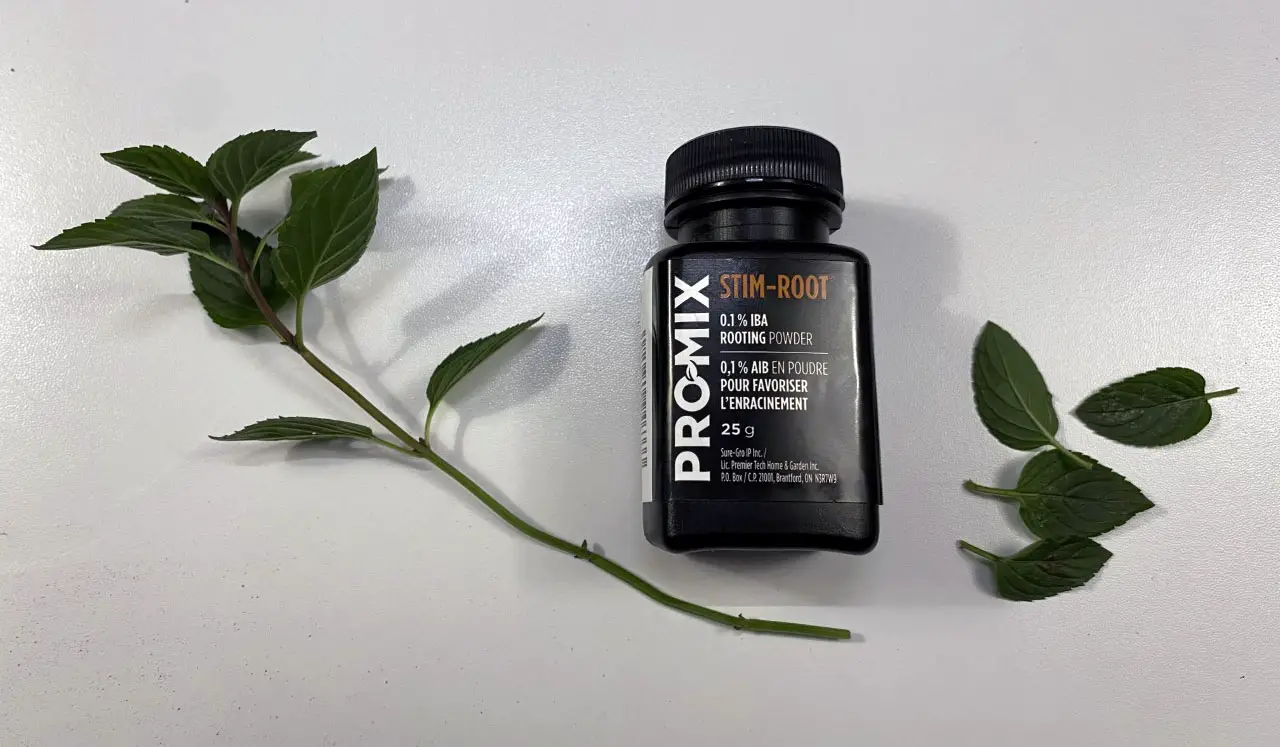How To Use Rooting Hormones? A complete Guide

This post follows our research editorial guidelines.

Gardeners often turn to high phosphorus fertilizers in the interest of helping seedlings and new trees get their young roots off to a good start. But what about when you grow a plant with no roots at all? I’m talking about propagating from cuttings! It allows me to know exactly what I’m getting in a plant, and gets my new clone off to a roaring start. Rooting hormones help immensely for those stubborn trees and shrubs that take a bit of extra work to get started.

Table of Contents
What are rooting hormones?
Rooting hormone is a synthetic compound designed to stimulate root development in cuttings. When applied to the end of a cutting, it triggers the development of new root growth quickly.
All plant growth is regulated by hormones, and the development of roots is no different.
Hormones are chemical signals, sent through the body of the plant in response to the environment around them. They control all kinds of growth, including roots, and how plants respond to inclement weather and even gravity!
Rooting hormones are a synthetic form of the hormone that triggers the production of new roots. There are a few different formulations, but all commercial blends achieve the same outcome – new roots where once were none.
What is a cutting?
A cutting is a length of twig, branch or vine, carefully clipped from a living plant with the intent to grow it as a whole new specimen. They can be roughly categorized into three types – hardwood, semi-hardwood, and softwood cuttings.
Hard wood cutting
A hardwood cutting is taken from older growth on woody shrubs and trees, typically the previous summer’s mature growth. They come in three forms – straight, heel, and mallet. They’re sometimes clipped free of new leaves and shoots, allowing the cutting to focus is growing on roots.
A straight cutting is as it sounds – a long, straight length of twig or stick, cut bluntly at both ends. The heel has a small portion of a larger branch attached, and a hammer cutting includes the whole point at which the cutting joined that larger branch.
Hardwood cuttings are best taken in the fall when the plant is gearing down for the year. Hormonal changes that signal the annual shutdown will also ready them for new growth in the spring.
Good candidates for hardwood cutting include willow, dogwood, and wisteria, as well as hydrangeas and pines.
Semi Hardwood cutting
A semi hardwood cutting is similar to a hardwood cutting in that it uses established growth, but in this case, it’s the same year’s growth and is taken in the late summer for immediate planting. These cuttings combine the fast striking of a softwood cutting with the stability and vigor of a hardwood.
Good candidates for semi-hardwood cuttings are azalea, rose, magnolia and pines.
Soft wood cutting
Softwood cuttings are taken from succulent new growth just as it starts to become firm. This is usually done at the height of the growing season, in the late summer, while the plant is still energetic but has put down some solid growth to serve as a foundation.
These cuttings come from the ends of branches or vines. They’re typically easier to coax into producing roots – also known as striking.
Good candidates for soft wood cuttings are camellia, gardenia, lilac and most herbs including rosemary and basil.

How to use rooting hormones:
“To obtain more uniform rooting, you should consider using a rooting compound containing indole butyric acid (IBA) or naphthalene acetic acid (NAA). Prevent possible contamination of the entire supply of rooting hormone by putting some in a separate container for dipping cuttings. I often use a small plastic sandwich bag. A small container of rooting compound lasts a long time. The brand makes little difference and instructions for use are included on the container.”
Quote: Jeff Schalau, Agent, Agriculture & Natural Resources, University of Arizona Cooperative Extension, Yavapai County
Choosing the right hormone
Most rooting hormones contain the same essential mix of hormones, but how they are delivered changes. They come in powdered, liquid and gel forms, and many brands also contain fungicides too. Each has their own benefits and drawbacks.
Powdered hormones
Powdered hormone is a great all rounder. It stores well, and can be applied easily to most cuttings. It’s hard to overuse, as it only sticks to the parts of the cutting that need it, making it easy for beginners to use without the risk of damaging your cuttings. It’s also pretty economical, and a small jar can last a long time.
It has a lower success rate, but for most uses, it’s a good choice.
Liquid Hormones
Liquid hormones are somewhat harder to work with. They often come as a concentrate and will need to be diluted before use. They’re also more potent and are easier to overuse and damage the cutting.
But if you’re a confident gardener, a liquid is a great choice. You can tinker with the dilution of the hormone, as some plants respond better to milder concentrations. It’s also more effective t getting into cells than a dry formula.
Gel Hormones
Gel hormones are a relatively new option, and combine the best of both worlds. They’re as straightforward as a powder, with the effectiveness of a liquid. They’re also great if you’re trying to coax a particularly tough customer into sprouting roots, like olive or citrus cuttings.
They do tend to be more expensive, gram for gram, than the other two, but many growers find the extra investment pays off with stronger, healthier new root growth.
Get the cutting ready that will be propagated
No matter what type of cutting you use, you’ll need to get the hormones onto fresh tissue. The wound must be clean, with no ragged edges.
Softwood cuttings are easiest. They can be cut from the parent plant and immediately treated.
Hardwood cuttings are a bit trickier. They’re best taken in late winter and can be stored in the refrigerator until spring. You also have to cut both the base of the cutting and remove any foliage above, while allowing at least two points of growth – or nodes – to remain.
Apply the rooting hormones to the cutting
Next you need to apply the hormone.
While it’s tempting to just up and dip the base right into the bottle, it’s best to put a small quantity into a sterile container and work from there. You don’t want sap or bits of dirt contaminating your entire bottle, after all!
To apply, gently dip or tap the end of your cutting into the hormone. For powder, you may want to dampen the tip of your cutting to help it adhere. Ensure the bottom of the cutting, including any nodes, are liberally dusted or otherwise coated in hormone.

Place in growing medium or propagator
Now it’s just a matter of planting. Different cuttings require slightly different treatment, as befits the differences in the cuttings.
How to Grow Softwood and Semi hardwood Cuttings
Softwood cuttings are fairly easy. They can be planted straight away into a pot of seed-raising mix or clean, well-draining potting medium. You’ll need to keep them moist and humid, so it’s a good idea to pop them in a propagator.
A propagator is a closed box designed to provide a warm, humid environment. Commercial propagators start with the familiar sealed seed tray, and at their most complex resemble tiny greenhouses complete with fans, heaters and integrated lighting.
It’s not too difficult to make a serviceable propagator yourself at home. All you really need to do is enclose the cutting and its pot in a clear bag or container. Provide enough light and warmth – either natural light or from a grow light – and the container will do the rest.
How to Grow Hardwood Cuttings
In contrast, hardwood cuttings want much the opposite – cold and dark!
Wrap the end of hardwood cuttings in damp peat, coco coir or even sawdust, and seal the lot in a plastic bag. They can then be placed in a cool dark area for four to six weeks as the roots develop.
Check regularly, and apply water with a plant mister if the growing medium becomes dry. Once their roots come in hardwood cuttings can be planted as normal, either out in the garden or in a container.
Avoiding contamination
Through this whole process, it’s important to avoid contamination, especially from fungi and bacteria. A juicy cut stem is a delicious treat to all manner of pathogens, and infant roots are vulnerable to damping off disease caused by Pythium and Phytophthora.
Both love the moist, humid conditions required to get those new roots growing, and both are notoriously hard to control once they’ve struck. It’s best to keep things clean and avoid infection in the first place.
Always use clean, sterile cutting tools, and only plant into clean, fresh soil. While pots can be re-used, it pays to clean and sterilize between uses.

4 plants that will not take root using root hormones
Some plants just don’t propagate well from cuttings. No matter how much you push, you won’t get roots from them. These include:
- Bulbs like tulips, jonquils or amaryllis
- Grasses
- Air plants
- Palm trees
FAQ
Can you use too much rooting powder?
Hormones are powerful, and it’s possible to ‘overload’ the new tissue and damage it, dropping the rate of success. It’s a powerful chemical, so always ready the instructions and only use as much as needed.
Rooting hormone also only stimulated the growth of delicate, fine roots that develop early during the rooting process. Once the fine roots are present, stronger ones then develop, but too much synthetic hormone can interfere with this process.
Does rooting powder work on all plants?
Not all plants respond to rooting powder. It all comes down to their biology.
Bulbs like tulips, for example don’t grow from cuttings. All their growth comes from the bulb below the soil. Palms are another example, and clumping grasses also fail to root.
How long does root powder take to work?
The time needed for a cutting to strike all comes down to the plant and the type of cutting. Most will see a reduction of a week or more, with the biggest impact noticed in softwood cuttings from fast growing plants.
Can I put rooting powder in water?
While you can add rooting powder to water, it may not dissolve well. It’s designed to cling to damp tissue and not disperse. After all, you don’t want it washing off the second you add your cutting to its growing medium.
If you want to grow roots in liquid, you can use a liquid rooting hormone instead. It’s already dissolved, ready to be added to your propagation stand or vessel.
Final thoughts
Propagating from cuttings is an almost magical experience. I love nothing more than taking a small portion of a beloved plant, rooting it, then passing it on to a friend. The use of rooting compounds makes it all the more likely I can pass on a little of that magic every time.
